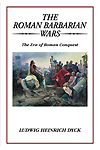
The Roman Barbarian Wars: The Era of Roman Conquest, by Ludwig Dyck, Trafford Publishing, Bloomington, Ind., 2011, $31.95
This important book examines in detail the wars Rome fought (see “Bloodlands: Rome” in the September 2012 Military History) against the barbarian tribes, from the founding of the nation-state (753 BC) to the establishment of the empire (24 BC). This period of Roman history is absolutely essential to an understanding of how Rome became an imperial state and how its citizen militia transformed itself into the best fighting force of the ancient world. Rome acquired more than a third of its imperial territory from these tribal conquests. It wrested from the Gauls at least a third of Italy (Cisalpine Gaul), as well as all of Gaul itself. The acquisition of Spain, a good part of Germany, and most of Eastern Europe and Britain all resulted from military victories over tribal armies.
The wars against the tribes also produced important changes in the Roman army’s tactical organization and weaponry. From the Samnites the Romans acquired the ciociara (military boot), scutum (shield) and deadly pilum (javelin). From the Celtiberians the Romans took the gladius hispansiensis (sword). The Gauls gave the Romans the grappling hook and boarding spike, and the Scythians introduced Rome to cataphracti (armored cavalry). Gaius Marius’ experience against the Teutons led him to change the tactical organization of the legion from maniples to heavier cohorts, with all soldiers equipped with the same weaponry and armor. And it was Julius Caesar’s experience with the Gauls that led him to change the field tactics and logistics of his army, changes later incorporated into the imperial army.
Most histories of the Roman army focus upon Rome’s wars with other states (Carthage, Greece, the Hellenic empires, etc.) neglecting to their fault the important period of Rome’s tribal conquests. Dyck has provided us with one of the few accounts of this period available to the general reader. Though it could have used more detailed maps, the book is well written, researched and organized, and, above all, highly informative.
—Richard A. Gabriel




